Richard Nissen really didn’t need another boat. At the beginning of the year, he already had a small fleet of at least eight small boats, not counting the houseboat he lives aboard on the River Thames. We have seen two of his boats in previous Reader Built Boat features—a skin-on-frame Walrus kayak and a Venetian s’ciopon. Nonetheless, in the spring he decided to build another boat, not so much to get afloat, but to occupy the time at home during the pandemic.
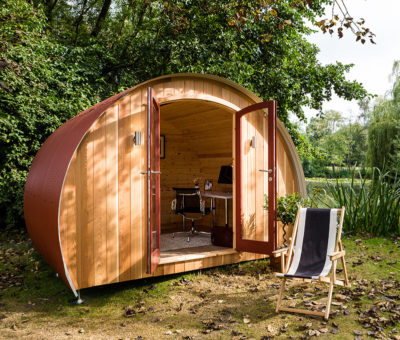 George Nissen
George NissenGeorge has gone into business designing and building a new peacetime version of his great-grandfather’s invention. The lumber left over from building this hut was what made it possible for his father to build the skiff.
He started the project in March at the beginning of a three-month lockdown in England. Under the restrictions imposed, “no person may leave the place where they are living without reasonable excuse,” so anything Richard chose to build would have to use the materials he had on hand. He happened to have a lot of 1/2″ tongue-and-groove pine that his son George had left over after building a prototype for a new kind of Nissen hut, or Quonset hut as it is called in North America.
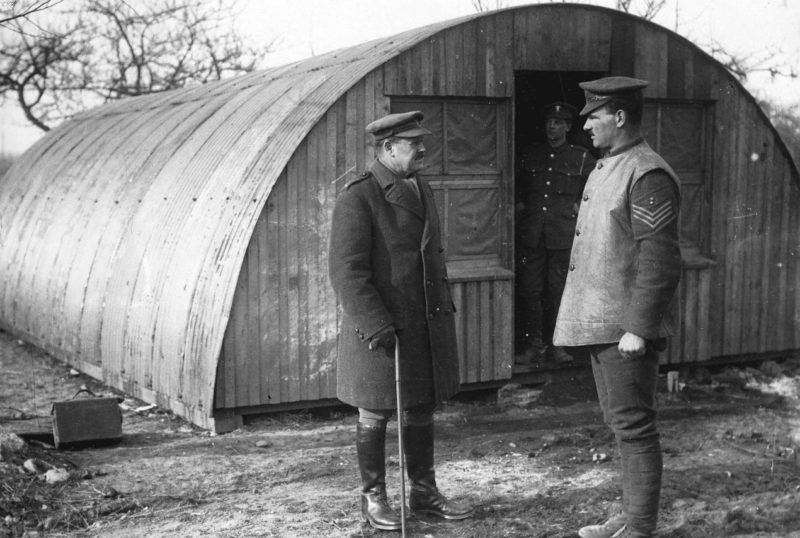 Courtesy of George Nissen
Courtesy of George NissenMajor Peter Norman Nissen, of the Royal Engineers, left, was awarded the Distinguished Service Order (DSO) for his service to the United Kingdom on the Western Front during World War I. Having invented the Nissen Hut as a serving soldier, he received no compensation for his design, but was allowed to patent it after the war.
Richard’s grandfather, Peter Norman Nissen, invented the Nissen hut in 1916. The iconic semi-cylindrical corrugated metal buildings were used to shelter British troops during World War I, and they proved to be good protection from bomb blasts and shrapnel. The American military adopted and adapted the design in 1941 and named them after Quonset Point in Narragansett Bay, Rhode Island, where a Navy construction center was building them. George designed his Nissen hut as a residential backyard retreat that could be used as a home office. His prototype had the signature Nissen curved metal roof and walls; the ends and the interior were sheathed with the tongue-and-groove pine. The leftovers of that stockpile were what Richard had available, so it was what he’d build a boat with.
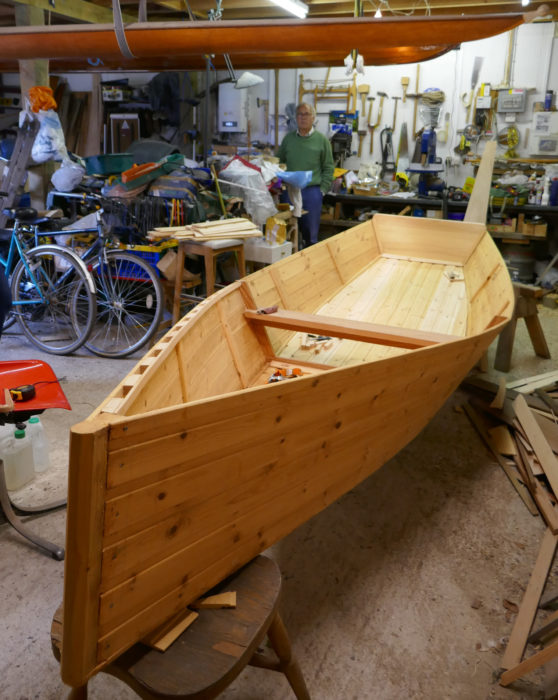 Courtesy of Richard Nissen
Courtesy of Richard NissenRichard, here standing at the back of his shop, is not one to be idle. He worked as an architect, moved on to develop a virtual office system, then set up a plumbing company called Staunch and Flow, and now putters with small boats and maintains a website devoted to the mysteries of animal navigation.
Richard also needed plans for a boat that would be simple to build and not too fancy for the knot-speckled pine that would go into it. He found an article by Greg Rössel about cross-planked flat-bottomed boats in a 20-year-old issue of Watercraft magazine. The article drew on a design originally presented in a boatbuilding manual published in 1917. It suited Richard’s vision for the project, almost. The boat would have had a beam of 5′ to 5-1/2′, but the oars he intended for the boat (given to Richard by his next-door neighbor) wouldn’t have been long enough for it, so he narrowed the beam to 4′.
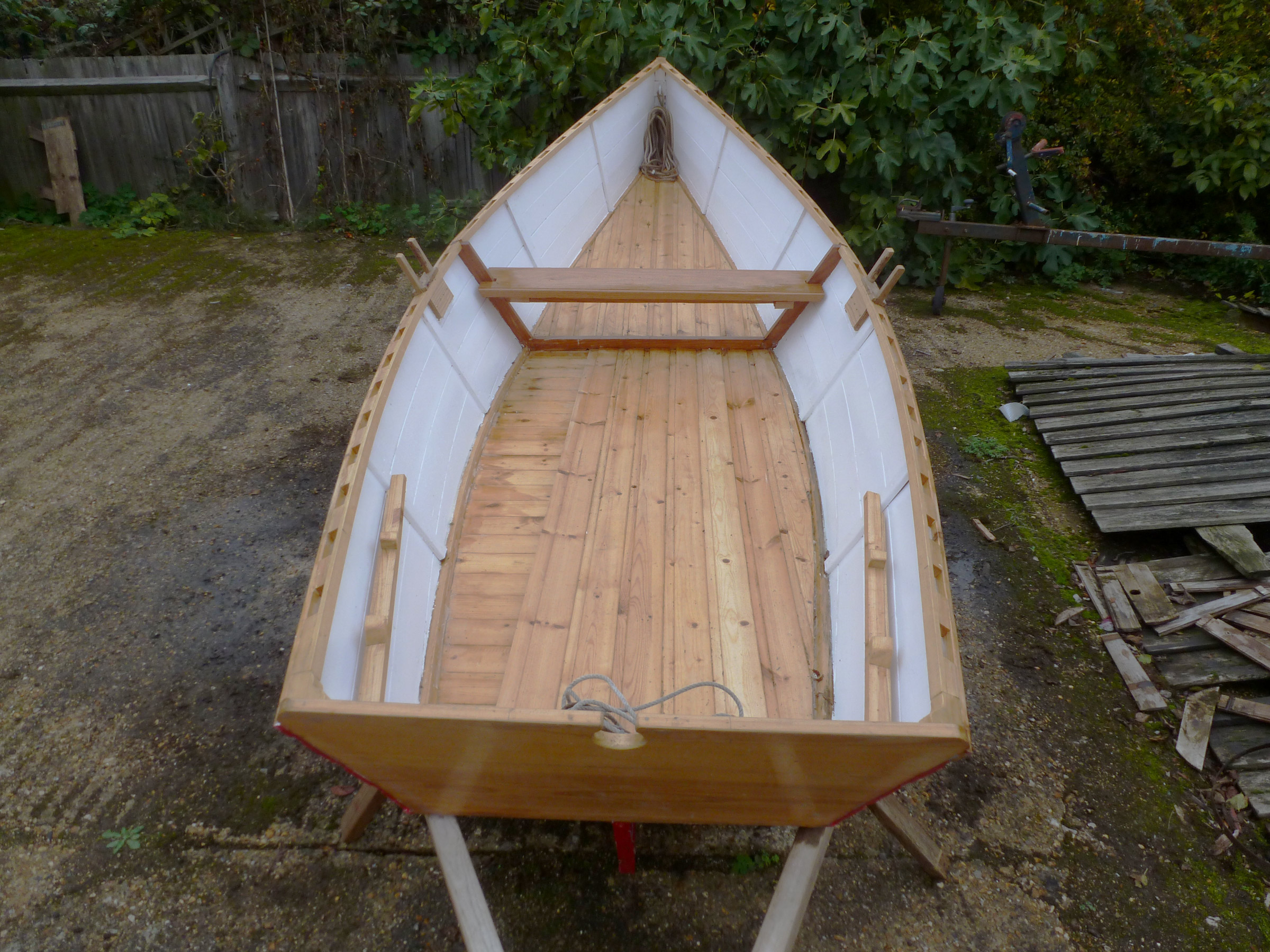 Richard Nissen
Richard NissenThe skiff’s cross-planked bottom was backed up with another layer of tongue-and-groove pine, laid lengthwise.
In 1917, each side of the boat would have been built with a single, wide plank, all but impossible to find these days, so Richard glued up each 17″-wide side from five pieces of the tongue-and-groove pine, using Gorilla Glue as an adhesive. Then, following the method from the 1917 book, he pinned the ends of the sides to a rabbeted stem, bent them around a single mold, and fastened the aft ends to the transom.
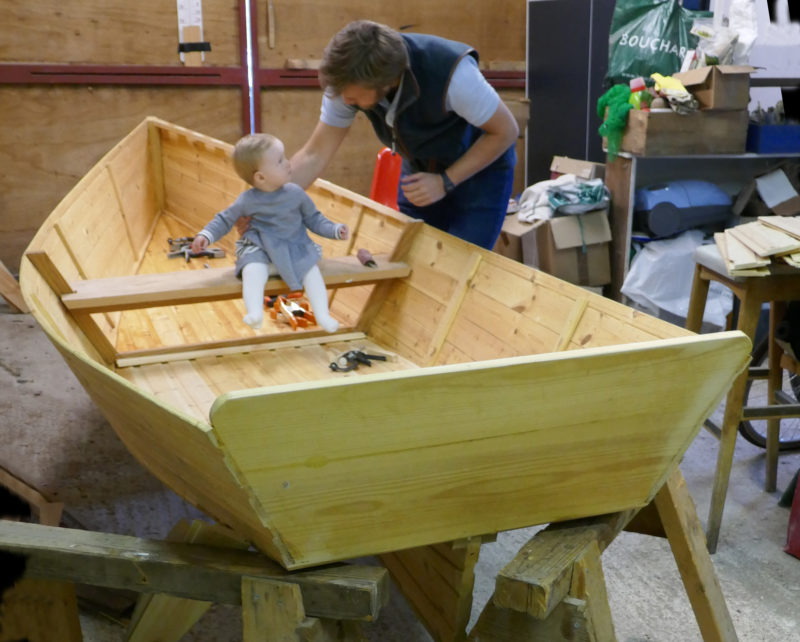 Courtesy of Richard Nissen
Courtesy of Richard NissenRichard’s son, George, brought his daughter to try the skiff out before the paint went on.
During the lockdown Richard worked on the boat every day, leaving home only for exercise allowed under the restrictions. He was building the boat outside and neighbors, taking their constitutionals on the path along the Thames, stopped by regularly to check on his progress.
After the sides were secure, chine logs installed along the bottom edge provided a place to fasten the cross-planked bottom. The interior face of the bottom later received a second layer of pine, laid fore-and-aft.
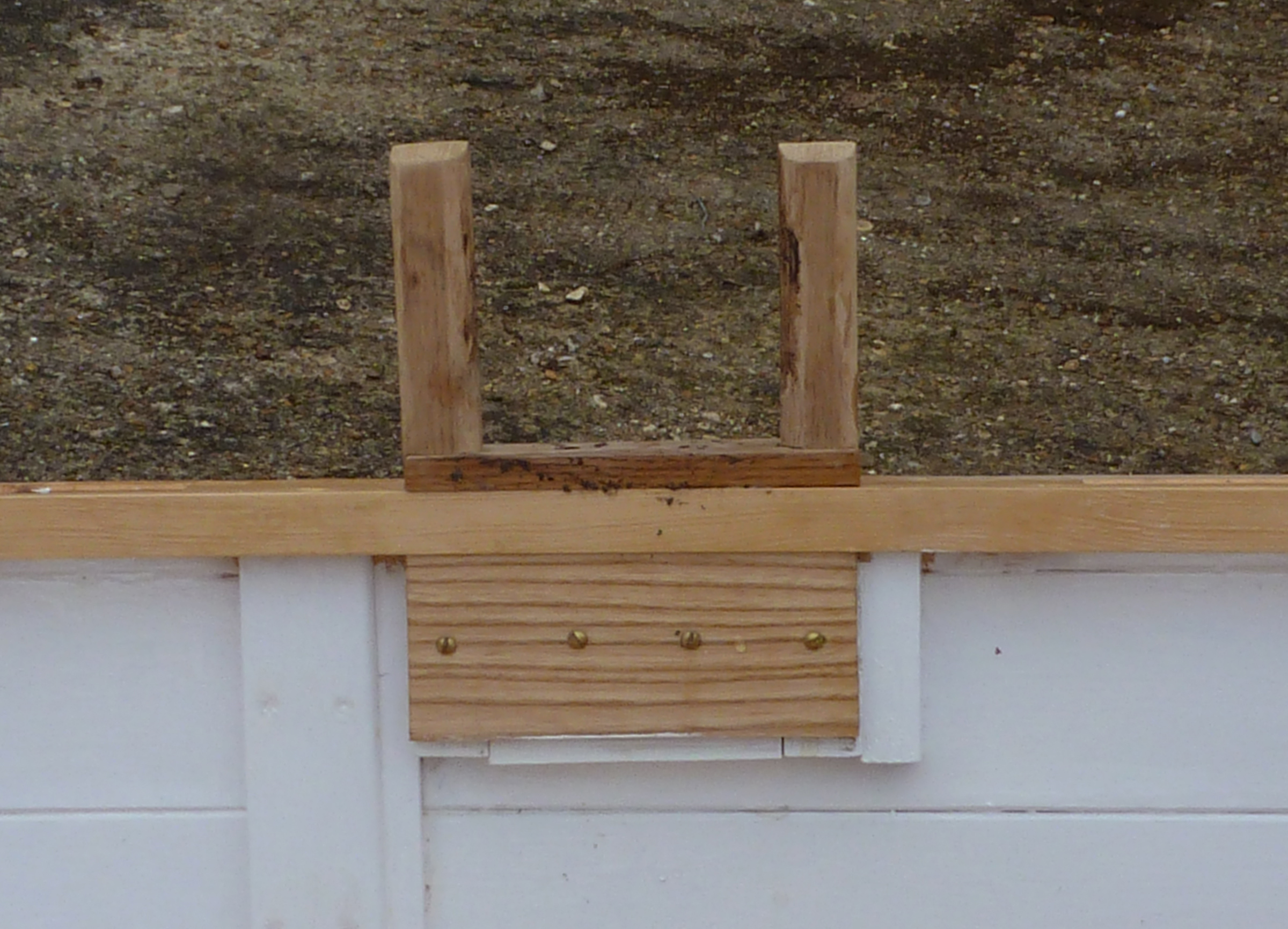
The double tholes on the skiff harken back to Richard’s days rowing as a schoolboy.
The main thwart in the boat was cut from a piece of 1″ Douglas-fir Richard happened to have in the shop. Instead of installing metal oarlocks, he equipped the boat with the same type of flat wooden tholes that he used as a schoolboy when he first started rowing, in lapstrake skiffs built in the 1920s. His father rowed with that same type of tholes in eight-oared shells he raced while a university student during World War II. In fact, the same kind of tholes have been in use on the Thames since the 14th century.
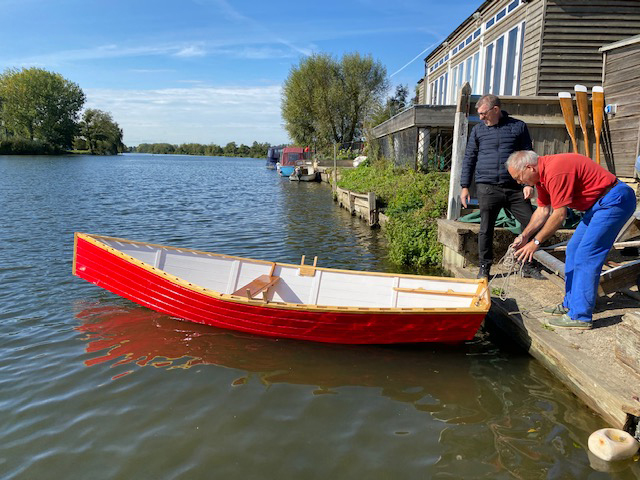 Courtesy of Richard Nissen
Courtesy of Richard NissenRichard, in the red shirt, introduced the skiff to the River Thames, at the bulkhead next to his houseboat.
Richard painted the hull exterior a bright red with the paint left over from the boot stripe on his 1920s motor launch. The paint has scarcely had time to get a few scratches in its comings and goings on the Thames but Richard is already at work on two more boats: a stitch-and-glue pulling boat he’ll equip with a sliding seat and racing sculls, and a Rob Roy canoe from the 1860s, given to him and in need of restoration. There’s no doubt that the time he spends at home staying safe will be time well spent.![]()
Do you have a boat with an interesting story? Please email us. We’d like to hear about it and share it with other Small Boats Magazine readers.
Comments:
We welcome your comments about this article. If you’d like to include a photo or a video with your comment, please email the file or link.

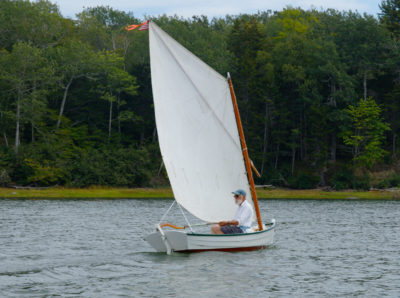
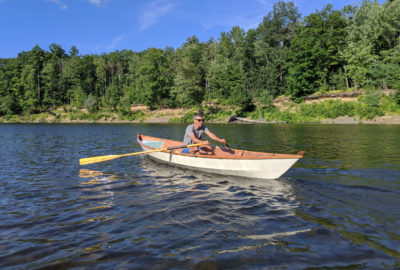
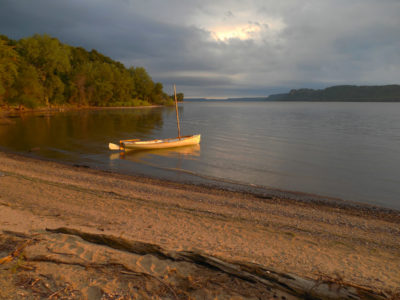
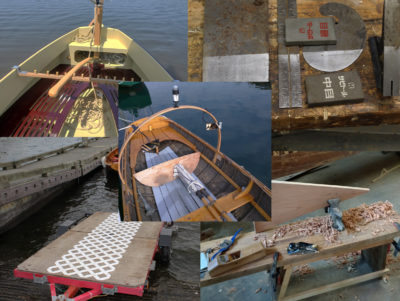
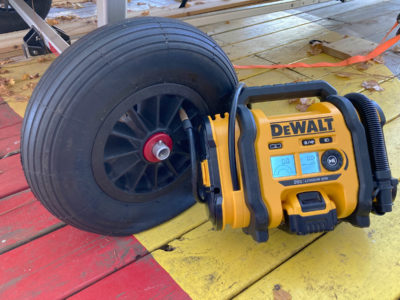
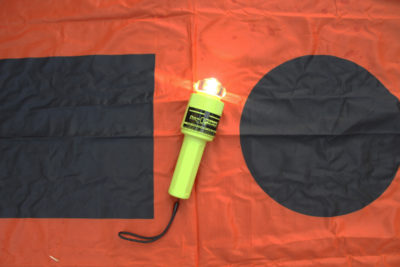
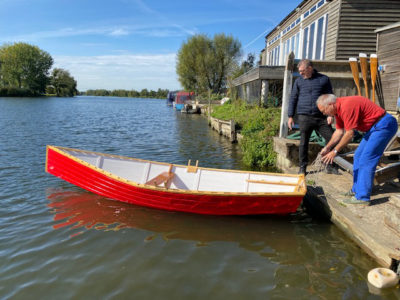
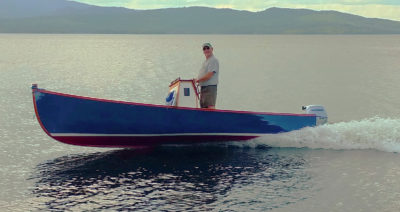
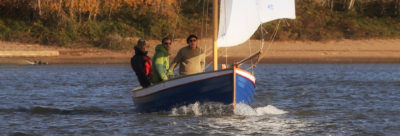
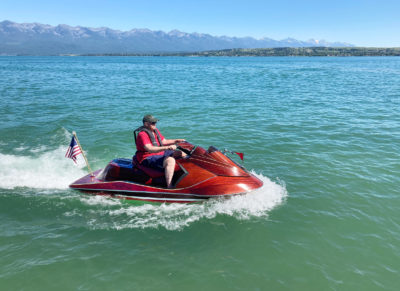
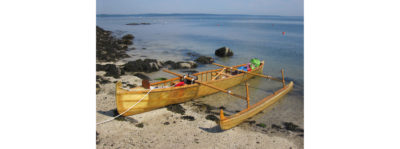
Very interesting use of the tongue-and-groove pine. We used some for a home remodel project recently and I wondered how it would fare in boatbuilding. Now we know. Enjoy your boat!
Kent and Audrey
This would be the equivalent of what Pete Culler recommended for dry-sailed cross planking, namely a splined bottom. Would be just fine.
Didn’t know about the background of the Nissen/ Quonset hut. Somewhere in the family is a photo of me at the age of a few months in front of my parents Quonset hut at Cape Shanks in New Jersey, where they were living courtesy the Army while Dad was going to Columbia Language school for an intensive course in Russian.